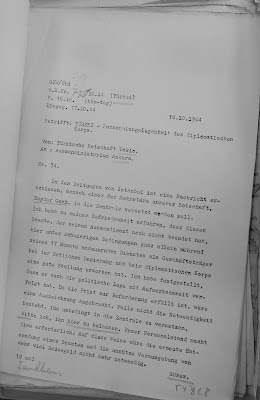In Wartime
exploitation of Turkish codes by Axis and Allied powers i’ve added the
following decoded Turkish diplomatic messages:
Military and intelligence history mostly dealing with World War II.
Thursday, April 20, 2017
Sunday, April 16, 2017
Update
In The
American M-209 cipher machine i’ve added notes and I’ve also added some
text (analysis of German trigram technique and a list of reports on the Hagelin
C-38).
Friday, April 14, 2017
Article on Vietnamese signals intelligence successes against French and US forces
The very interesting article ‘Cryptography During the French and
American Wars in Vietnam’ by Phan
Duong Hieu and Neal Koblitz is available
online.
Sunday, April 9, 2017
A misogynistic mistake!
In The
Finnish cryptologic service in WWII I’ve added ‘Head of the diplomatic department was Mary Grashorn’.
Mary Grashorn
was mentioned in the essay ‘Finland’s
codebreaking in WWII’ by David Kahn. I don’t know how I missed that.
Tuesday, April 4, 2017
The quest for the missing NAASt 5 reports
During WWII
the German Army’s signal intelligence agency operated a number of fixed
intercept stations and also had mobile units assigned to Army Groups. These
units were called KONA (Kommandeur der Nachrichtenaufklärung - Signals
Intelligence Regiment) and each had an evaluation centre, a stationary
intercept company, two long range signal intelligence companies and two close
range signal intelligence companies.
Each KONA
regiment was assigned to an Army group and was responsible for intercepting and
decoding enemy traffic. KONA 5 was
stationed in Western Europe and their cryptanalytic centre NAASt 5 (Nachrichten Aufklärung Auswertestelle - Signal
Intelligence Evaluation Center) worked mainly on the radio traffic of the US
and UK forces.
In
1944 NAAS 5 personnel started solving the settings of the US M-209 cipher
machine, used at division level by the US Army.
In late 1944
the cryptanalysts of NAAS 5, led by Reinold
Weber, built a
cryptanalytic device in order to solve the settings of the M-209 device
more quickly.
In order to
learn more about this device and the way it was used I’ve tried to locate any
surviving reports of NAAS 5. According to the TICOM report IF-272 - TAB ‘D’ the
following NAAS 5 reports survived the war:
E-Bericht Nr.
1/44 der NAAst 5 dated 10.1.44
E-Bericht Nr.
2/44 der NAAst 5
E-Bericht Nr.
3/44 der NAAst 5 (Berichtszeit 1.4-30.6.44)
E-Bericht 4/44
der NAAst 5 (Berichtszeit 1.7-30.9.44) dated 10.10.44
E-Bericht der
NAAst 5 (Berichtszeit 1.10.44-30.12.44) dated 14.1.45
The first
three can be found in the US national archives, collection RG 457 - Entry 9032 -
box 22, titled ‘German deciphering reports’.
Unfortunately
the last two (covering the second half of 1944) are not there.
I asked NARA
if they could locate the missing reports elsewhere in collection RG 457 but
they could not. I also requested the reports from the NSA’s FOIA office. In October
2016 they responded that the NAAS 5 reports were included in transfer group TR-0457-2016-0014.
I then
contacted the NARA FOIA office and asked for the release of the NAAS 5 reports.
The material in transfer group TR-0457-2016-0014 was classified so they would
have to locate the reports and then review them for declassification. Unfortunately
they have checked the files several times and they cannot locate any file
titled E-Bericht NAAst 5.
So at this time I am trying to find a solution with the NSA and NARA
FOIA office.
In the
meantime if you know more about this case, if you think you have a better
chance of locating the missing reports etc give it a try.
Subscribe to:
Posts (Atom)


















